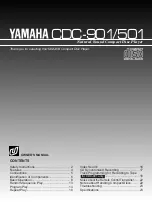
11
screws.
■ The bearings on the cutterhead are factory lubricated
and sealed. They require no further attention.
PERIODIC MAINTENANCE
■ The build-up of sawdust and other debris can cause
your machine to plane inaccurately. Periodic cleaning
is mandatory for precision planing and is highly
recommended.
■ Close fitting parts, such as the lockbars and the planer
cutterhead slots, should be cleaned with a brush;
remove clinging foreign matters. Then replace all parts
in their respective positions slightly dampened with oil.
■ Remove resin and other accumulations from feed
rollers and table with a non-flamable solvent.
ENVIRONMENTAL PROTECTION
Recycle raw materials instead of disposing
of as waste. The machine, accessories
and packaging should be sorted for
environmental-friendly recycling.
SYMBOL
Safety alert
Regulatory Compliance Mark (RCM).
Product meets applicable regulatory
requirements.
Please read the instructions carefully
before starting the product.
Class II tool, double insulation
Wear ear protection
Always wear eye protection
Waste electrical products should not be
disposed of with household waste. Please
recycle where facilities exist. Check with
your Local Authority or retailer for recycling
advice.
per the following procedures.
■ Remove the height adjustment crank handle and
both top and side covers by removing allen screws to
expose the height adjustment lock nuts.
■ Loosen the adjustment lock nuts.
■ Adjust the height adjustment lock nuts up or down as
required to suit the gauge block.
■ When the desired height setting is reached, tighten the
lock nuts in position.
■ Reassemble side and top covers and replace the
height adjustment crank handle.
NOTE:
Remove gauge block before starting machine.
Thickness planing is the sizing of the material to a desired
thickness, while creating a smooth surface parallel to the
opposite side of the board.
The art of thickness planing consists mainly of using good
judgement about the depth of cut in various situations.
You must take into account:
1. The width of the timber
2. The hardness of the timber
3. The dampness of the timber
4. The straightness of the board
5. The grain direction
6. The grain structure
How these factors can affect the quality of the work can
only be learned through experience. Whenever working
with a new type of wood, or one with unusual problems,
always make test cuts on scrap material prior to working
on the actual piece.
FOR ADDITIONAL PLANING
If additional planing is needed to obtain the desired
thickness of finish, hand crank the cutterhead no more
than 3 mm (at any given time) and complete another pass.
WARNING
Never plane more than 3 mm in one pass and never
attempt to plane a board under 127 mm (5") in length.
Always wear a protective face shield.
MAINTENANCE
LUBRICATION
■ The recommended lubrication for roller chains used in
medium to low operation is to simply wipe the chain
clean. When there is an excess build-up of dust or
wood shavings, etc., coat the chain with a light film
of oil but never pour the oil directly on the chain.
Over-oiling tends to hasten the collection of dust
and woodshavings and works them into members of
the chain leading to increased wear and premature
replacement. This applies to the speed reduction and
height adjustment chains as well as the elevation































